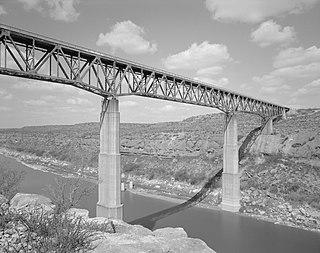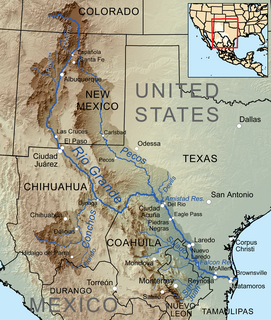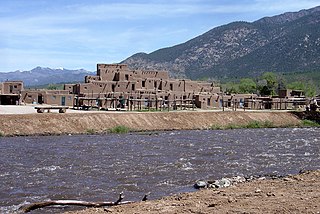| Río Álamo | |
| Country | Mexico |
|---|---|
| State | Tamaulipas |
| Mouth | Rio Grande |
| - location | Ciudad Mier |
| - coordinates | 26°25′N99°6′W / 26.417°N 99.100°W Coordinates: 26°25′N99°6′W / 26.417°N 99.100°W [1] |
| Basin | 4,339 km2 (1,675 sq mi) [2] |
| Discharge | for IBWC station 08-4642 at Ciudad Mier |
| - average | 3.67 m3/s (130 cu ft/s) [2] |
| - max | 2,470 m3/s (87,227 cu ft/s) |
| - min | 0 m3/s (0 cu ft/s) |
The Río Álamo, is a stream in the state of Tamaulipas, Mexico, and is a tributary of the Rio Grande. It is impounded by Las Blancas Dam, which was completed in 2001 and diverts water to the Marte Gómez Reservoir on the Rio San Juan, another tributary of the Rio Grande. [2]

Tamaulipas, officially the Free and Sovereign State of Tamaulipas, is one of the 31 states which, with Mexico City, comprise the 32 Federal Entities of Mexico. It is divided into 43 municipalities and its capital city is Ciudad Victoria.

Mexico, officially the United Mexican States, is a country in the southern portion of North America. It is bordered to the north by the United States; to the south and west by the Pacific Ocean; to the southeast by Guatemala, Belize, and the Caribbean Sea; and to the east by the Gulf of Mexico. Covering almost 2,000,000 square kilometres (770,000 sq mi), the nation is the fifth largest country in the Americas by total area and the 13th largest independent state in the world. With an estimated population of over 120 million people, the country is the eleventh most populous state and the most populous Spanish-speaking state in the world, while being the second most populous nation in Latin America after Brazil. Mexico is a federation comprising 31 states and Mexico City, a special federal entity that is also the capital city and its most populous city. Other metropolises in the state include Guadalajara, Monterrey, Puebla, Toluca, Tijuana and León.

The Rio Grande is one of the principal rivers in the southwest United States and northern Mexico. The Rio Grande begins in south-central Colorado in the United States and flows to the Gulf of Mexico. Along the way, it forms part of the Mexico–United States border. According to the International Boundary and Water Commission, its total length was 1,896 miles (3,051 km) in the late 1980s, though course shifts occasionally result in length changes. Depending on how it is measured, the Rio Grande is either the fourth- or fifth-longest river system in North America.
The Rio Alamo enters the Rio Grande (Rio Bravo del Norte in Mexico) at Rio Grande river kilometer 422 kilometres (262 mi), about 20 kilometres (12 mi) downriver from Falcon Dam. [2]

Falcon Dam is an earthen embankment dam on the Rio Grande between Starr County in the U.S. state of Texas and the city of Nueva Ciudad Guerrero in the Mexican state of Tamaulipas. The dam was built for water conservation, irrigation, hydroelectric power generation, flood control, and recreational purposes and as an international border crossing between Zapata and Starr Counties and Tamaulipas. Construction on the dam began in December 1950 and ended in April 1954 but it was dedicated by presidents Adolfo Ruiz Cortines and Dwight D. Eisenhower in October 1953.













